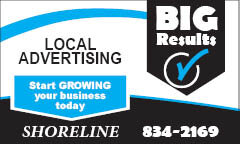By Craig Westcott | Irish Loop Post
Innovate or die. That’s the message Fermuese native and technology entrepreneur Karl Kenny delivered earlier this month as the guest speaker at the Celtic CBDC’s annual general meeting held in Bay Bulls during Small Business Week.
Kenny, who got his first introduction to the important of technology to the modern world as a member of the Canadian navy, sketched a resume of his career to date, the lows as well as the highs, and offered a bit of advice for the small business operators in the room.
"Someone said to me the other day, 'Karl, we're seeing you in the news a lot, you've been a real overnight success.'” Kenny said. “I said, 'It's been a really long night baby, a really long night.'"
The member of Newfoundland and Labrador's Business Hall of Fame has had a rollercoaster career in the high technology industry, earning millions in company divestitures at some points and crashing to a receivership on the bottom end at another point. But he is still clearly hooked on the opportunities available in high tech.
Kenny said his first job was pumping gas at Jim Kenney's gas bar in Fermuese. "It was great, I was making 35 bucks a week, which worked out to about 65 cents an hour at the time,” he recalled. “Then I joined the navy and had a great career and learned a lot. I was a kid and I learned a lot about leadership and persistence and doing hard work."
Kenny said there is an important distinction between innovation and invention.
“People think they are the same, and they’re not,” said Kenny. “Invention is the creation of something, and innovation is taking that invention and making it better. I’ll put it into kind of a context here: John DeLorean lost $200 million building the DeLorean car. He invented the DeLorean. Steven Spiegel took it and did the Back to the Future series and made almost $2 billion in profit by innovating the DeLorean."
Sony is a similar example, Kenny argued. It invented, with its Walkman, the idea of walking around with a compact, mobile play list of music. "Look at what Apple has done with that?" he said. "That's what innovation is really all about."
Kenny said after leaving the navy he moved to Seattle and became a contractor to Microsoft.
"I didn't invent the mouse,” he said addressing a popular myth about him Newfoundland business circles as to how he made his first million. “The mouse was invented back in '65. I sold that company in 1990. I had some options when Microsoft went public. It put some jingle in my jeans. I was only a kid, I was not even in my 30s then, and I took three years off and travelled the world.”
In 1993, said Kenny, he began work with an electronic charting system, the kind of technology that others eventually refined into Google Maps. “I sold that company to an Italian firm in '93. Again, you think you're doing something really smart, but I didn't see the Google Maps play, so I sold way ahead of time,” said Kenny. “The big news in my life so far has been Telepix. I started Telepix in '96... I sold that for $100 million. People say, 'A hundred million dollars!' It didn't all stick to Karl's fingers, I had lot of investors and shareholders and bankers... But again, a little bit of jingle goes into the jeans. But I should have waited, because a couple of years after that along came Instagram and facebook and Snapchat and youtube with enterprise values in the billions. Missed it again!”
Kenny co-founded Marport in 2003, a marine technology company in St. John’s. It had actually started in Iceland some years before. His main partner was St. John’s businessman Derrick Rowe, who had famously, at least in local business circles, been part of a group that ousted Vic Young and the board of directors of FPI Limited in a hostile takeover. The pair bought and reconstituted Marport as a St. John’s company. It garnered many headlines for technological successes, but like many high tech start-ups, struggled financially. It eventually went into receivership with ACOA chasing it at one point for $2.3 million in unpaid loans. Some of its high tech sonar products, as did Kenny, survived.
“That was really, really cool stuff,” Kenny said of the products Marport developed, some of them in use in his current company, Kraken Robotics. “We got a lot of patents, international awards,” he said. “We brought in a private equity group out of Boston that I made a really bad deal with. It was a big mistake, lost a lot of money, the jingle in my jeans and the other things sort of went down the pipe. And that was bad. But I exited with some really cool technology, synthetic aperture sonar technology and a handful of really, really smart boys and girls in terms of engineers and scientists.”
That’s when Kenny started Kraken, with six employees in 2012, operating out of the same building where Marport had been located.
"We're now 60 people, (with) international operations,” said Kenny. “We started off doing sensors, this thing called synthetic aperture sonar. It does really high-resolution imaging on the seabed, it lets us find very small objects at very long ranges. It was designed primarily, initially for military applications, but now it's getting a lot of attention in the oil and gas sector and we just finished some major projects there offshore. These things sell for around $350,000 to $400,000 a pop. So they're not flying off the shelves like hamburgers or stuff that, but there is a market for them."
Kenny said at first Kraken sold the sensors to other companies for use in their robots. "But then we said, let's move up the food chain, let's start building our own robots and adding value to our own building and material costs."
Along the way, Kenny said, Kraken Robotics has leveraged significant investment with the company going public three years ago on the TSX. "We're exporting to 10 countries we have 60 people, (including) 10 PhDs, and as a small company we're pursuing about $250 million worth of business internationally right now,” said Kenny. “So we are not hunting elephants. The technology has been validated. But this is not about the boat, this is about the sailors, it's about the team that allows us to get where we are today. This is not the Karl Kenny show, this is the Kraken show."
A while ago, Kenny said, the people at Kraken sat back and looked for ways to increase its profit margins on sales, someone it was able to do.
"Our average selling price now ranges from $50,000 to over $3 million (U.S.) a pop,” he said. “This is a very broad portfolio… So we got good margins out of this which allows us to invest continually into our R&D. And that's one of our strategies, relentless innovation to be able to drive these products to these types of customers - Lockheed Martin, Boeing, the US Navy, Atlas Electronic in Germany, Ocean Infinity. These guys aren't fools, so the level of due diligence that's done in our company in terms of commercial, technical and intellectual property is pretty intense."
This fall, Kraken technology is been used by Ocean Infinity in a project offshore Newfoundland. Ocean Infinity is also an investor in Kraken, Kenny noted. The international marine surveying company is running sea trials on two underwater robots offshore Newfoundland on a ship that is using Bay Bulls as its local port. The underwater visualization gear is Kraken technology.
"This is the way of the future," said Kenny. "We're going to be taking people out of harm's way and putting robots down deep. We're operating at depths of up to 6,000 metres, the full ocean depth, to get down deep and find everything from underwater mines to pipelines to cables to treasure."
Kraken recently won awards for technology that is being used in offshore wind farms, Kenny noted.
"You've got to know where the money is, you've got to go to where the money is," said Kenny. "I see a lot of small companies blow their brains out by chasing opportunities they can't ever realize, they run out of cash and then they die… We firmly believe that robots are changing everything, everything from manufacturing to production to medical, we've all heard about the Google self-driving cars, we're going to see the same thing in our world. The dull, dirty and dangerous jobs that humans are doing today, machines should be doing... And the market is growing significantly. It's a huge, huge opportunity for us."
Kenny’s speech drew rapt attention from audience members, a good many of whom pressed him with questions and requests for advice.
"So what have I learned so far? I've learned a lot,” Kenny said. “I've learned you win, I've learned you lose, and I've learned you make money and I've learned you lose money. And as I said earlier, it's not about your boat, it's about your team, it's the sailors round that that, that's what's going to get you there. And the most important things in life aren't things. I used to think it was. But after you buy a couple of fancy cars and you get all that stuff, there are more important things. Money to me just gave me financial independence, it just gave me a little jingle in the jeans (so) that I didn't have to do crap that I didn't want to do... Don't be miserable. How many people do I see who are miserable in their job and they're not happy. Do more of what makes you happy, whatever that is. When Dad was alive, we used to go rabbit hunting up in Fermuese. And I'd say, 'Dad, there's a rabbit, there's a rabbit, there's a rabbit, let's go chase the rabbit.' And he said, 'No, no, no. We're going to get one rabbit, because if you chase a whole bunch of rabbits, you're going to go home hungry.' So the lesson there is stay focused on what you do. And it's hard sometimes, particularly in small technology companies... Stay focused on what you do. Also know where you're going. And if you don't have the courage to cannibalize yourself, if you don't have the courage to continue to innovate, the competition will and you will be out of business."

